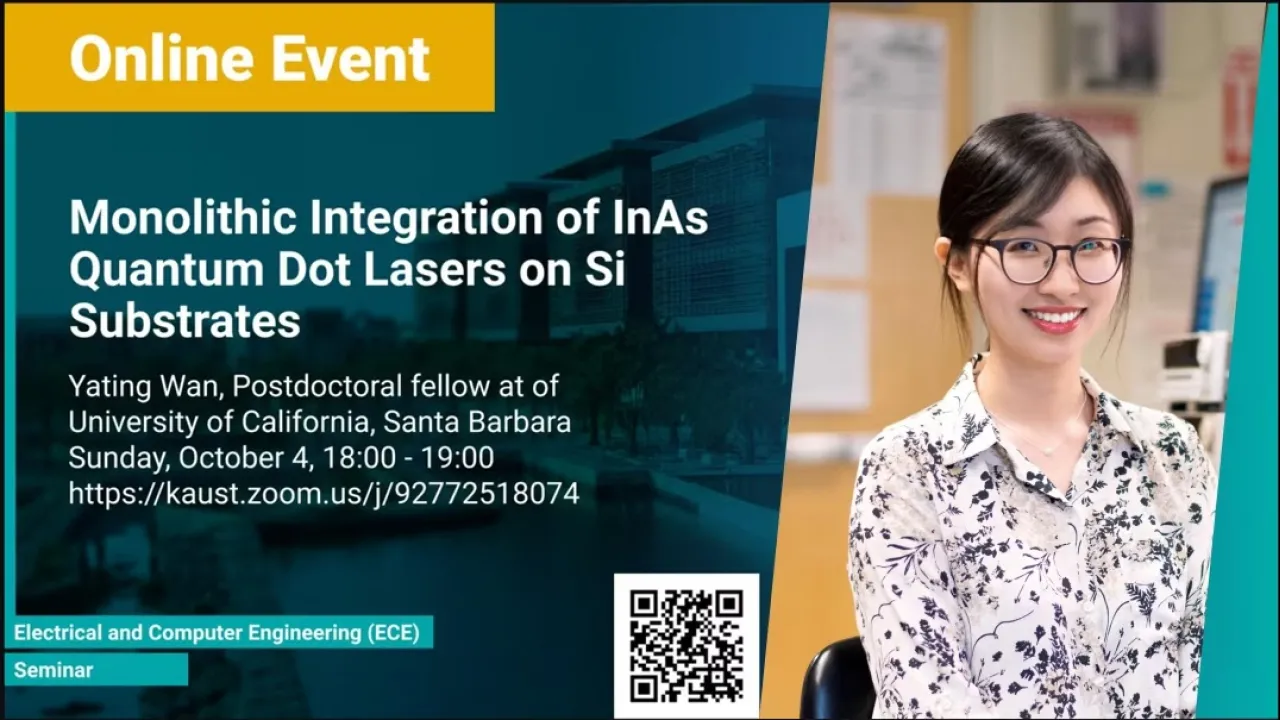
Monolithic Integration of InAs Quantum Dot Lasers on Si Substrates
- Yating Wan, Postdoctoral fellow at of University of California, Santa Barbara
KAUST
Here, I will talk about recent advances in the field of QD lasers with a focus on direct growth on Si. Si photonics has found widespread application, particularly for high volume applications and for co-integration with CMOS electronics. I will start with an overview of the field, followed with a summary of device performance and fundamental physics basis for the improved response.
Overview
Abstract
A self-assembled quantum dot (QD) gain medium has multiple favorable material properties over conventional quantum-well (QW) structures and bulk materials, including large tolerance to material defects, reduced reflection sensitivity, nearly zero linewidth enhancement factor, low transparency current density, high temperature operation, and ultrafast gain dynamics useful for semiconductor mode-locked lasers and amplifiers. Here, I will talk about recent advances in the field of QD lasers with a focus on direct growth on Si. Si photonics has found widespread application, particularly for high volume applications and for co-integration with CMOS electronics. I will start with an overview of the field, followed with a summary of device performance and fundamental physics basis for the improved response. A subset of recent advances include 119°C continuous wave lasing, near zero linewidth enhancement factors, isolator-free stability, extrapolated lifetimes of more than 100 years at 35°C, continuous-wave sub-milliamp threshold in micro-scale ring laser cavities, high on-chip gain (39 dB) amplification, 4.1 Tb/s transmission using mode-locked lasers with record-low timing jitter of 82.7 fs, and tunable lasers with over 45 dB side-mode-suppression-ratio and 16 nm tuning range. Significant progress has been made in the last decade, making commercialization of QD technology likely for practical III-V/Si photonics.
Brief Biography
Yating Wan obtained her Bachelor of Science in 2012 with a specialization in optics at Zhejiang University in China (GPA: 3.97/4.0), and received her Ph.D. (2017) in the Department of Electrical and Computer Engineering from Hong Kong University of Science and Technology (HKUST) (GPA: 3.94/4.0).
She was selected as the winner of the School of Engineering PhD Research Excellence Award 2016-17, one of the best two among many nominations received from all Engineering Departments in HKUST, for her pioneering work in integration of long wavelength quantum dot micro-lasers on silicon substrates.
She has published 32 (19 as first author/corresponding author) high quality peer-reviewed journal papers, 20 international peer-reviewed conferences proceedings (9 as first author). Her first-author journal papers have been selected as the journal cover for five times (Optica, Laser & Photonics Review(twice), Applied Physics Letter, Photonics Research), her first-author book chapter was selected as the cover of the book 《Future Directions in Silicon Photonics》and her first-author conferences proceedings include three invited talks (2018 CLEO, 2018 PIERS, 2018 ACP), one postdeadline paper (2017 CLEO). Her work has been cited 1102 times in peer-reviewed journal articles (h-index:17 according to google scholar on 9/11/2020) and has received extensive recognition by more than 30 professional communities and 10 social media coverage.
She is now a Postdoctoral fellow at of University of California, Santa Barbara (UCSB) in Prof. John Bowers' group, to develop quantum dot lasers for low threshold and high efficiency, photodetectors, modulators and photonic integrated circuits. Materials integration, nanoscale fabrication to probe and push the performance of photonic structures using micro-cavities.
